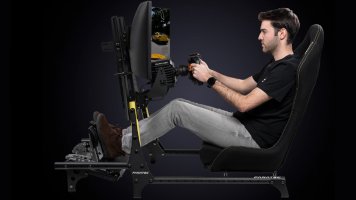"Having a go" by providing a more accurate alternative to the aerodynamics which are objectively correctly modeled for what they are (really you shouldn't be "fudging" them at all - unlike the tires there's nothing that you can even argue should be "fudged")? Wow.
Ok - I'll play your silly little 'word' game.
A C5 Z06 presents a certain aerodynamic model. In stock form. The car was placed in a wind tunnel and the preeminent body supplier of the era assisted in the exercise.
The default lift behavior of the car was noted and documented.
Then, based on GM's advice and input
based purely on theoretical input made some changes to the car - and tested the results in the wind tunnel to gauge the result.
Results where NOT as expected, and other physical changes where made based on the operators and teams experience.
The desired results where obtained. And results documented.
So, based on practical experiment, certain, wing, hood, fender, splitter and diffuser changes garnered specific results.
I have been in direct dialogue with the people who designed the cars race body work and managed the iterative changes to the C5 Z06 race program and am well aware of what these iterative changes where and the results on the race car and their wind tunnel tested cars - as well as the results when applied to a street car (closed windows and popped head lights contribute another series of results not applicable to the race car but of interest to street drivers.)
Pay attention to this important bit: Certain components and changes where NEVER modeled or theoretically tested beyond practical application. So their specific contributions to this day are unknown - but what is known is the total accumulative results of their application to the chassis.
In other words - you don't have the raw numbers to put in your pretty little spreadsheets, but the actual results are known and documented.
So what you do is take the data you have (in your pretty little spread sheets) and then the CHANGE them until you get the feel and results you know they (the various added components) provide - all the while knowing and understanding the LIMITATIONS of the GAME ENGINE you are working with.
After all YOU are one of the people who INSISTED that there is no practical way for a GAME ENGINE to dynamically and in real time calculate ALL possible aerodynamic components - besides which we only have a defined number of aero component tables to manipulate.
YOU are one of the folks who admitted that aero in the end is a fudge factor. And here you are claiming it is not - that in the context of a GAME ENGINE it is a very precise and accurately modeled component that is fed with pages and pages of spreadsheet calcs.
All your spreadsheets are pointless if the result does not FEEL correct, besides the fact that the actual per component aero contributing values of specific hoods, splitters, diffusers and fenders is UNKNOWN. Only the cumulative RESULT is known and only the cumulative result is applied .i.e. the total wind tunnel down force of front and rear weight sensor results.
It is after all, only a GAME ENGINE right?











